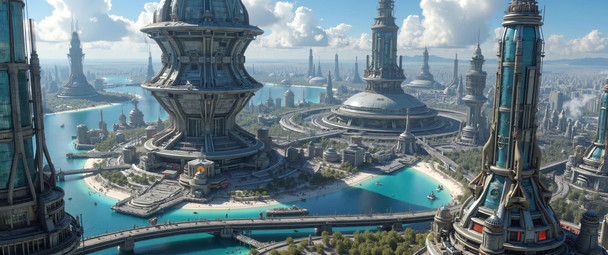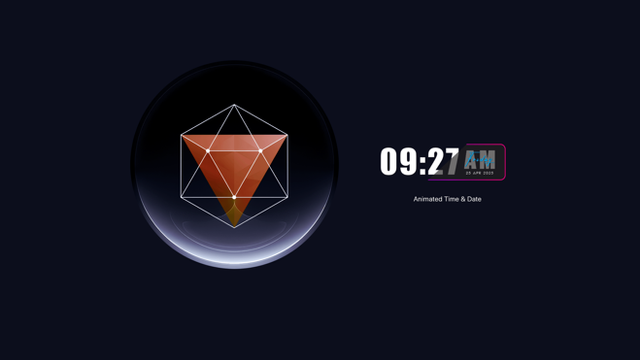HOME | DD
 steve-burg — Codd M317-C Process
steve-burg — Codd M317-C Process

Published: 2011-09-18 16:41:24 +0000 UTC; Views: 3093; Favourites: 43; Downloads: 149
Redirect to original
Description
Since some folks have inquired, I put together this overview of some of the elements that go into a 3D "paint-over" type image.I try and get the 3D render as close to what I'm envisioning as possible, and right down to texture, lighting, color pallet and fog or atmosphere.
In this case, I knew a lot of the scene would rely on the sky, which was going to be painted. But I rendered out a huge 8K image of the planet which would appear behind the clouds.
I usually render out a separate ambient occlusion pass, which I use for various purposes - in this case, to preserve crispness in the shadows as I painted in some additional atmosphere.
The final image is the result of a lot of painted details blended in, and fine tuning of things such as the contrast and color balance. The little dust devils and hovercraft ships were 2D elements painted to match the lighting in the 3D scene.
I experimented with some radical departures from the initial color scheme, but in the end I went full circle and kept the colors more or less as they appeared in the first render.
BTW - the 3D was created in Lightwave 9.6, and the final image was put together in Photoshop





As an illustrator coming from traditional media, I always feel that 3D is somehow "cheating" - but it's a fair amount of work to create a 3D scene, so I guess it isn't really a cheat at all





Related content
Comments: 25

THe difference between 3D and traditional is that with 3D it has both more detail and is able to be used in just about everything. While a traditional sketch is now-a-days for the design of the 3D model. And yet, somehow sketching it up does seem quickers, and it doesn't give me a headache, probably because I am still working out how to use Blender.
However, I can see now that rendering the model was quite simple, while you repeated textures on the structures.
BTW - love the planet and the effects, makes the image fell larger.
👍: 0 ⏩: 1

The 3D also allows you to try different approaches to the lighting much more quickly than trying to change it in 2D! This started out as a night scene, then I introduced sunlight.
And of course, the 3D can also be used for animation!
👍: 0 ⏩: 1

Before 3D they just mashed together tank and ship models, just look at the Nostromo and you'll see those tank pieces.
👍: 0 ⏩: 0

I am from a traditional media background myself and remember stacking various objects and /or bits of Airfix kits together to make up the outline shapes for outposts, ships and space stations ect, for my Sci-Fi artwork and trolling through countless photos for reference for skies ect to draw and paint, usually very time consuming. I started using 2D and 3D software and discovered a whole new way of working, I still like to sketch out ideas but with a 3D model you can change the angle, shape and lighting in an instant, at first I too felt I was cheating a bit but now I regard 3D software as a one of the best tools an artist could have in their toolkit.
Excellent work
👍: 0 ⏩: 1

I did much the same thing as you describe!
I kind of jumped into 3D with both feet - and I love it! But I'm kind of glad I learned the basics before adopting the digital tools. Well, there was no choice - none of this stuff existed when I was a sprout-ling!
👍: 0 ⏩: 0

I'm confused about the Ambient Occlusion Render stage. Why is that necessary? Great work!
👍: 0 ⏩: 2

The ambient occlusion helps in a number of ways. It can be used as a selection, to keep the shadowy recesses looking sharp. Also, it can be overlayed to reassert the edges of an object. All that stuff can start to get a little fuzzy when you get into a lot of layers and painting over the image.
👍: 0 ⏩: 1

"to preserve crispness in the shadows as I painted in some additional atmosphere."
👍: 0 ⏩: 0

I'd have to agree, coming from a drawing board and tee square myself to 3D, theres no cheating at all, one still uses the same visualisation processes and it is a lot more work getting the model correct to your conceptions. I have no where near your skills in this field being as I am just a plain old hobbyist but seeing works such as you display are a true inspiration to improve.
👍: 0 ⏩: 1

Yeas - the challenge of 3D is to keep the thing on track and achieve the initial intent. 3D is very powerful, and I always have to be a little careful not to get sidetracked. On the other hand... sometimes the "3D accident" winds up bringing a better result, something not imagined at the outset
👍: 0 ⏩: 0

omg 3D is not cheating at all, it's a whole other "universe" to master! so really great! love this little overview
👍: 0 ⏩: 1

Oh, I know it's not cheating - I guess that's just left over from the time when I had to do all the perspective and lighting and everything all by hand! I love 3D - and also 2D - pretty much everything has appeal
👍: 0 ⏩: 0

Love the atmosphere- excellent concept and work.
👍: 0 ⏩: 1

Looking very nice. Always informative to see the workflow of other artists
👍: 0 ⏩: 1

I like to see stuff like that myself - so once in a while I try to put together a sort of "look behind the curtain"
👍: 0 ⏩: 0






























